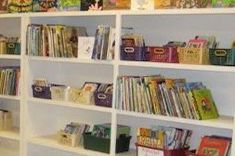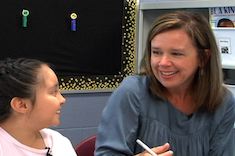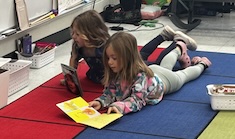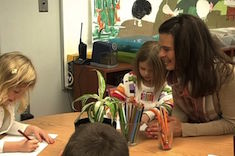2nd
Latest Content
Indoor Walks
Gigi McAlister discovered that using indoor walks is a way to help students engage in their learning and strengthen their learning community through conversations.
Pick One: How to Establish a Community of Readers
“Pick one!” These are the words that begin to grow a community of readers. When students say, “I’m done,” Becca Burk points toward the classroom library and encourages them to pick a book and begin growing strong roots as a reader.
Reclaiming Space: Weeding to Grow a Healthy Library
Books, like gardens, need to be tended to regularly for the whole library to thrive. Gigi McAllister gives tips for anyone in the weeding process for their school or classroom library.
You Know How to Show Them
Becca Burk tackles the issues associated with distraction when it comes to helping students engage with a book rather than a device.
Morning Hike
Gwen Blumberg helps us consider and create space for a variety of personalities and learning needs. Inspired by a morning hike, she takes her observations and applies them to give space for all students to learn.
Responding to Dysregulated Behaviors: What about the other kids?
Becca Burk reflects on the other kids in the classroom who witness dysregulated behaviors from a classmate. She reminds us of the way grace and acceptance are prominent when we look for the silver linings in difficult situations. This is the third installment of a four-part series chronicling the responses when a student with dysregulated behaviors joins Becca Burk’s kindergarten class mid-year.
Responding to Dysregulated Behaviors: A Symptom of What?
When a new student spirals into anxiety and becomes aggressive, Becca Burk finds herself with a dislocated knee and advocating for the student to return to the classroom. This is the second installment of a four-part series chronicling the responses when a student with dysregulated behaviors joins Becca Burk’s kindergarten class mid-year.
Let’s Begin
Gwen Blumberg reflects on the community developed at a writing retreat and encourages teachers to consider the community of learners they will intentionally nourish this school year.
Responding to Dysregulated Behaviors: “What’s a Book?”
When a new student joins Becca Burk’s kindergarten classroom and asks, “What’s a book?” Becca realizes some behaviors are new to even the most veteran teachers. This is the first installment of a four-part series chronicling the responses when a student with dysregulated behaviors joins Becca Burk’s kindergarten class mid-year.
Do I Belong?
Tammy Mulligan considers ways to help students feel and know that they belong in the classroom community. The more we broaden our knowledge of others, and discover more about who we are and what we care about, the more our sense of belonging can grow.
Kindergarten Celebration of Writing
Molly James encourages us to consider ways to make a writing celebration meaningful. You’ll be inspired by her kindergarten writing celebration.
Revisiting: Getting to Know My Students
Mandy Robek decided that despite the increasing pressures and time-consuming expectations, she will nourish healthy relationships with students. Here are some tried-and-true practices that she wants to maintain.
Fostering Reading Lives in the Library
Gigi McAllister fosters engaged reading lives through goal-setting in the library. She shares ways we can encourage all readers to have robust reading lives.
Story Walks
Christy Rush-Levine invites students into a story walk. While many of our school activities require students to sit still and be quiet, story walks with wordless books are a simple way to invite students to move and talk, with powerful outcomes.
Early Writing Opportunities in the Library
Gigi McAllister shares informal writing opportunities for students in the school library. Informal and engaging writing activities where students have lots of choice and encouragement make them feel empowered as writers, help them generalize the writing skills they are learning in the classroom, and create joyful writing experiences.
Tips for Interactive Word Study
Lisa Mazinas offers tips for building fluency in elementary readers.
Eight Tips to Make Virtual Learning Equitable and Accessible for All Students
Lisa Mazinas reminds us of ways to make virtual learning equitable and accessible.
Responding to Appeals for Help
Dana Murphy outlines three options to respond to a student who is stuck when reading and looking to the teacher for the answer. By being mindful when students appeal for help, we can make intentional, on-the-spot decisions to empower students to become better readers.
The Power of Story
Becca Burk reminds us of the power of story and community when she uses a social story to help a kindergartner overcome the fear and anxiety from being forgotten on the bus. Becca shows us how to use a social story to develop confidence to overcome difficulties.
Fostering a Love of Reading in All Students
Lisa Mazinas reminds us of the importance of fostering a love of reading in all students. She offers specific ways to reconnect students with the enjoyment of reading.
Let’s Do It Again, Together
Heather Fisher revisits a whole-school vocabulary routine that she set in motion. In this update, she shares the ways she adjusted to work together as a team rather than fly solo. This might be just the school-wide vocabulary routine you’ve been craving.
Writing About Reading
Mandy Robek is on a quest to make writing about reading feel natural with her elementary students. She shares practical ways to help students change the way they approach writing about reading to lift the level of comprehension and conversation.
Morning Message 5 — Meaning and Content Connections
In this installment of the morning message series, Ruth Metcalfe unlocks a wide range of opportunities to support learning in any content area.
Morning Message 4: Application and Differentiation
The possibilities for differentiation during morning message are almost endless. Ruth Metcalfe highlights ways to meet a wide variety of needs via the morning message.
Morning Message 3: Word Study and Conventions
There is much debate in today’s educational landscape around what and how to teach young readers about print. No matter what your classroom realities are around teaching how sounds, words, and language work, Ruth Metcalfe attests that using a morning message is an engaging way to support word study and conventions.
Morning Message 2: Routine and Community
Ruth Metcalfe reminds us of the power of routines and shows how over the course of time, morning message is an anchor in her first-grade classroom community.
Step Into Poetry: Building a Poetry-Conscious Classroom
Joanne Emery has curated a fabulous list of resources and ideas to build a poetry-conscious classroom community.
Morning Message Series: When and How
It’s not always easy to hold on to effective instructional routines and find ways to embrace new initiatives and mandates. In the first installment of a morning message series, Ruth Metcalfe addresses the issue of time.
When They’re Hard to Teach
Cathy Mere reminds us of the complexities of teaching readers, especially those who are in intervention. She shares the “rules” she’s put in place for herself when a rough patch is hit and little growth is gained.
Reclaiming Our Time
Vivian Chen gives four steps to adjusting a lesson from the teacher’s guide to reclaim your time and make the lesson more meaningful and engaging to students.
Browse Content By
Type
Category
- Assessment Tools
- Big Fresh Archives
- Booklists
- Choice Numeracy
- Classroom Design
- Common Core
- Community Building
- Conferring
- Content Literacy
- Digital Literacy
- English Language Learners
- Equity
- Family Relations
- Free Samples
- Guiding Groups
- Leadership
- Literacy Coaches
- Mentor Texts
- Minilessons
- New Teacher Mentors
- Podcasts
- Poetry
- Quote Collections
- Reading Strategies
- Self Care
- Struggling and Striving Learners
- Talking and Listening
- Teacher Study Groups
- Teaching Reading
- Teaching Writing
- Word Study and Vocabulary
Author
- Melissa Quimby
- Nawal Qarooni
- Gwen Blumberg
- Julie Cox
- The Lead Learners
- Hannah Tills
- Josie Stewart
- Ruth Metcalfe
- Mallory Messenger
- Becca Burk
- Jodie Bailey
- Vivian Chen
- Mary Brower
- Tiffany Abbott Fuller
- Stephanie Affinito
- Ruth Ayres
- Leigh Anne Eck
- Heather Fisher
- Shari Frost
- Julie Johnson
- Suzy Kaback
- Gigi McAllister
- Shirl McPhillips
- Melanie Meehan
- Cathy Mere
- Debbie Miller
- Tara Barnett and Kate Mills
- Tammy Mulligan
- Dana Murphy
- Bitsy Parks
- David Pittman
- Brenda Power
- Heather Rader
- Matt Renwick
- Mandy Robek
- Christy Rush-Levine
- Gretchen Schroeder
- Jen Schwanke
- Brian Sepe
- Katherine Sokolowski
- Stella Villalba
- Jennifer Vincent
Grade Level
Choice Literacy Membership
Articles
Get full access to all Choice Literacy article content
Videos
Get full access to all Choice Literacy video content
Courses
Access Choice Literacy course curriculum and training























